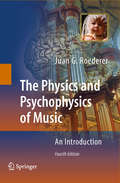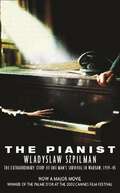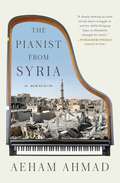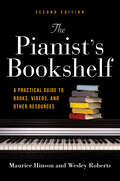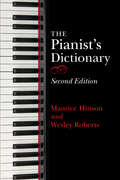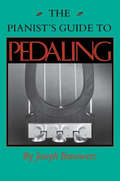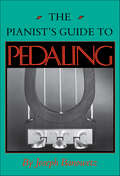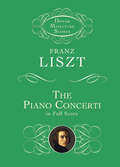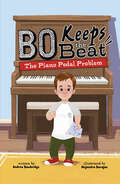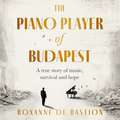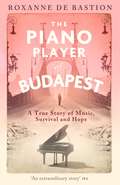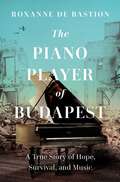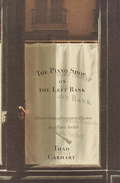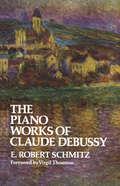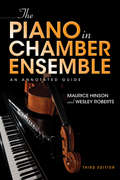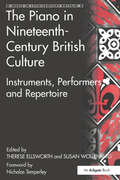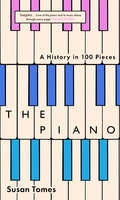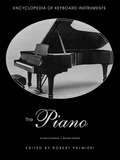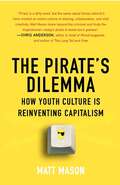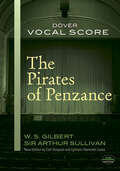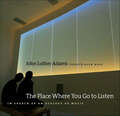- Table View
- List View
The Physics and Psychophysics of Music
by Juan G. RoedererThis introductory text deals with the physical systems and biological processes that intervene in what we broadly call "music." It analyzes what physical properties of sound patterns are associated with what psychological sensations of music, and describes how these sound patterns are actually produced in musical instruments, how they propagate through the environment, and how they are detected by the ear and interpreted in the brain. Without using complicated mathematics, the author weaves a close mesh between the disciplines of acoustics, psychophysics, and neurobiology, offering an integral picture of not only the science of music, but also the "music of science", that is, the beauty and excitement of scientific research, reasoning and understanding. This text should be accessible to undergraduate-level students, whether from science, arts or engineering schools, but it should also be useful to professional musicians, physics educators, acoustical engineers and neuroscientists. The fourth edition incorporates recent research on tone generation in musical instruments and latest findings in brain science.
The Physics of Music: Integrating the Technical and Artistic Aspects of Creating Music (Undergraduate Lecture Notes in Physics)
by Gordon P. RamseyThis textbook is designed to help students and professionals understand the intimate connection between music and physics. The reader does not need prior background in music or physics, as the concepts necessary for understanding this connection are developed from scratch, using nothing more sophisticated than basic algebra which is reviewed for the reader. The focus is on connecting physics to the creation of music and its effect on humans. The reader will learn about the basic structure of music in relation to acoustics concepts, different musical instrument groups, how the room affects sound, and how sound travels from instruments to human ears to evoke an emotional reaction. Replete with exercises to hone students’ understanding, this book is ideal for a course on the physics of music and will appeal to STEM students as well as students, professionals, and enthusiasts in any field related to music and sound engineering.
The Pianist
by Anthea Bell Wladyslaw SzpilmanDramatic story of a pianists survival of World War II in Poland.
The Pianist
by Wladyslaw SzpilmanThe bestselling memoir of a Jewish pianist who survived the war in Warsaw against all odds.'We are drawn in to share his surprise and then disbelief at the horrifying progress of events, all conveyed with an understated intimacy and dailiness that render them painfully close... riveting' OBSERVEROn September 23, 1939, Wladyslaw Szpilman played Chopin's Nocturne in C-sharp minor live on the radio as shells exploded outside - so loudly that he couldn't hear his piano. It was the last live music broadcast from Warsaw: That day, a German bomb hit the station, and Polish Radio went off the air.Though he lost his entire family, Szpilman survived in hiding. In the end, his life was saved by a German officer who heard him play the same Chopin Nocturne on a piano found among the rubble. Written immediately after the war and suppressed for decades, THE PIANIST is a stunning testament to human endurance and the redemptive power of fellow feeling.'The images drawn are unusually sharp and clear... but its moral tone is even more striking: Szpilman refuses to make a hero or a demon out of anyone' LITERARY REVIEW
The Pianist from Syria: A Memoir
by Aeham AhmadAn astonishing but true account of a pianist’s escape from war-torn Syria to Germany offers a deeply personal perspective on the most devastating refugee crisis of this century.Aeham Ahmad was born a second-generation refugee—the son of a blind violinist and carpenter who recognized Aeham's talent and taught him how to play piano and love music from an early age. When his grandparents and father were forced to flee Israel and seek refuge from the Israeli–Palestinian conflict ravaging their home, Aeham’s family built a life in Yarmouk, an unofficial camp to more than 160,000 Palestinian refugees in Damascus. They raised a new generation in Syria while waiting for the conflict to be resolved so they could return to their homeland. Instead, another fight overtook their asylum. Their only haven was in music and in each other. Forced to leave his family behind, Aeham sought out a safe place for them to call home and build a better life, taking solace in the indestructible bond between fathers and sons to keep moving forward. Heart-wrenching yet ultimately full of hope, and told in a raw and poignant voice, The Pianist from Syria is a gripping portrait of one man’s search for a peaceful life for his family and of a country being torn apart as the world watches in horror.
The Pianist's Bookshelf, Second Edition: A Practical Guide to Books, Videos, and Other Resources
by Maurice Hinson Wesley RobertsOriginally published in 1997, The Pianist's Bookshelf, was, according to the Library Journal, "a unique and valuable tool." Now rewritten for a modern audience, this second edition expands into the 21st century. A completely revised update, The Pianist's Bookshelf, Second Edition, comes to the rescue of pianists overwhelmed by the abundance of books, videos, and other works about the piano. In this clear, easy-to-use reference book, Maurice Hinson and Wesley Roberts survey hundreds of sources and provide concise, practical annotations for each item, thus saving the reader hours of precious research time. In addition to the main listings of entries, such as "Chamber Music" and "Piano Duet," the book has indexes of authors, composers, and performers.A handy reference from the masters of piano bibliography, The Pianist's Bookshelf, Second Edition, will be an invaluable resource to students, teachers, and musicians.
The Pianist's Dictionary
by Maurice Hinson Wesley RobertsFrom A to Z to middle C: An &“essential reference&” for piano students, teachers, players, and music lovers, with hundreds of definitions (E.L. Lancaster, Alfred Music).The Pianist&’s Dictionary is a handy and practical reference dictionary aimed specifically at pianists, teachers, students, and concertgoers. Prepared by Maurice Hinson and Wesley Roberts, this revised and expanded edition is a compendium of information gleaned from a combined century of piano teaching. Users will find helpful and clear definitions of musical and pianistic terms, performance directions, composers, pianists, famous piano pieces, and piano makers. The authors&’ succinct entries make The Pianist&’s Dictionary the perfect reference for compiling program and liner notes, studying scores, and learning and teaching the instrument. &“This new edition is a go-to source for piano scholars and students for quick information on musical terms, pianists, major works in the piano repertoire, piano manufacturers, and more . . . comprehensive, easy to use.&” —Jane Magrath, University of Oklahoma
The Pianist's Guide to Pedaling
by Joseph BanowetzJoseph Banowetz and four distinguished contributors provide practical suggestions and musicological insights on the pedaling of keyboard works from the 18th to the 20th century.
The Pianist's Guide to Pedaling
by Joseph Banowetz" . . . a most precious book which every serious pianist and teacher must own." —Journal of the American Liszt SocietyJoseph Banowetz and four distinguished contributors provide practical suggestions and musicological insights on the pedaling of keyboard works from the 18th to the 20th century.
The Piano Concerti
by Franz LisztOne of the greatest piano virtuosos of all time, Franz Liszt composed piano music marked by its technical brilliance, innovation, and imagination. This collection presents authoritative miniature score editions of two staples of the repertoire: Liszt's Piano Concerto No. 1 in E-flat Major and his Piano Concerto No. 2 in A Major.The works are reproduced here from authoritative editions, complete with bar-numbered movements for easy reference. Affordable, durable, and portable, this miniature score edition is ideal for study in the classroom, at home, or in the concert hall.
The Piano Pedal Problem (Bo Keeps the Beat)
by Andrew BambridgeBo really wants to take piano lessons like his older brother Jason. But there are two problems—his mom says he’s not ready, and his feet can’t reach the foot pedals because of his achondroplasia. But Bo knows that where there’s a problem, there’s a solution! With determination and the help of a kind teacher, Bo tackles the piano problem, and his feet and fingers finally feel the music! Musician, educator, and actor Andrew Bambridge (Pixels) offers a charming chapter book series about a boy named Bo who, like Andrew, has achondroplasia and has always loved music.
The Piano Player of Budapest: A True Story of Holocaust Survival, Music and Hope
by Roxanne de BastionOne man, his piano and their miraculous survival.'Extraordinary' Baroness Julia Neuberger'Stunning. A beautiful blend of action, poetry, thought-provoking comment and music ... just brilliant' James Ainscough OBE'A gripping narrative of suffering, loss and survival, with music at its heart' Fiona MaddocksAll future, freedom and success lay ahead of young pianist Stephen de Bastion in 1930s Hungary. Life whirled headily around cocktails, romance, applause and the buzz of Budapest late into the night. Then, 1939. Stephen's world disintegrates and this becomes a story of his brutal descent, of his time in labour camps, of Mauthausen and Gunskirchen and the unimaginable horrors he endured during the Holocaust as a man of Jewish descent. Yet, this is also a tale of extraordinary escape ... and the piano, waiting for him.The same piano that Roxanne de Bastion, his granddaughter, inherits when her father dies. It has been in the family over one hundred years but it is only when, deep in grief, she discovers a cassette recording of Stephen, that the astonishing history of the piano, the man and her family begins to unravel. Weaving together his original recordings, unpublished memoirs, letters and documents, Roxanne sings out her grandfather's story of music and hope, lost and found. Luminous and profoundly moving, this book captures the great spirit of one man in the face of darkness and the hope that echoes down through generations.
The Piano Player of Budapest: A True Story of Holocaust Survival, Music and Hope
by Roxanne de BastionOne man, his piano and their miraculous survival.'Extraordinary' Baroness Julia Neuberger'Stunning. A beautiful blend of action, poetry, thought-provoking comment and music ... just brilliant' James Ainscough OBE'A gripping narrative of suffering, loss and survival, with music at its heart' Fiona MaddocksAll future, freedom and success lay ahead of young pianist Stephen de Bastion in 1930s Hungary. Life whirled headily around cocktails, romance, applause and the buzz of Budapest late into the night. Then, 1939. Stephen's world disintegrates and this becomes a story of his brutal descent, of his time in labour camps, of Mauthausen and Gunskirchen and the unimaginable horrors he endured during the Holocaust as a man of Jewish descent. Yet, this is also a tale of extraordinary escape ... and the piano, waiting for him.The same piano that Roxanne de Bastion, his granddaughter, inherits when her father dies. It has been in the family over one hundred years but it is only when, deep in grief, she discovers a cassette recording of Stephen, that the astonishing history of the piano, the man and her family begins to unravel. Weaving together his original recordings, unpublished memoirs, letters and documents, Roxanne sings out her grandfather's story of music and hope, lost and found. Luminous and profoundly moving, this book captures the great spirit of one man in the face of darkness and the hope that echoes down through generations.
The Piano Player of Budapest: A True Story of Survival, Hope, and Music
by Roxanne de BastionA story about a piano and its most prodigious player—and how they both survived one of the darkest periods in history.When her father died, singer-songwriter Roxanne de Bastion inherited a piano she knew had been in her family for over a hundred years. But it is only when she finds a cassette recording of her grandfather, Stephen, playing one of his compositions, that the true and almost unbelievable history of the piano, this man, and her family begins to unravel. Stephen was a man who enjoyed great fame, a man who suffered the horrors of concentration camps in WWII, a man who ultimately survives—along with his piano. By piecing together his cassette recordings, unpublished memoirs, letters, and documents, Roxanne sings out her grandfather's story of music and hope, lost and found, and explores the power of what can echo down through generations.
The Piano Shop on the Left Bank
by Thad CarhartThad Carhart never realized there was a gap in his life until he happened upon Desforges Pianos, a demure little shopfront in his Pairs neighborhood that seemed to want to hide rather than advertise its wares. Like Alice in Wonderland, he found his attempts to gain entry rebuffed at every turn. An accidental introduction finally opened the door to the quartier's oddest hangout, where locals -- from university professors to pipefitters -- gather on Friday evenings to discuss music, love, and life over a glass of wine.Luc, the atelier's master, proves an excellent guide to the history of this most gloriously impractical of instruments. A bewildering variety passes through his restorer's hands: delicate ancient pianofortes, one perhaps the onetime possession of Beethoven. Great hulking beasts of thunderous voice. And the modest piano "with the heart of a lion" that was to become Thad's own.What emerges is a warm and intuitive portrait of the secret Paris -- one closed to all but a knowing few. The Piano Shop on the Left Bank is the perfect book for music lovers, or for anyone who longs to recapture a lost passion.From the Hardcover edition.
The Piano Works of Claude Debussy (Dover Books on Music)
by E. Robert SchmitzThis book is a firsthand report of a great composer's intentions in regard to the performance of his music. These intentions have been digested and interpreted for us by the composer's friend Robert Schmitz (1889–1949), who was himself a distinguished pianist, an articulate musician, and a well-known teacher. The product is an authoritative commentary on the entire body of Debussy's work for piano solo.Written for both performers and listeners, the book's purpose is to increase enjoyment of and insight into these works. The book's shorter opening section comprises notes on many general aspects of the composer's life and work; a biographical sketch; a discussion of Debussy's place in relation to the concepts of impressionism and romanticism; his use of classical forms, tonality and modality, melody, counterpoint, etc. Section two, the heart of the book, examines in detail the whole of Debussy's music for solo piano, two hands. Seventy-one pieces in all are included: The Arabesques, the Suite Bergmasque, the Estampes, Images, Children's Corner, Préludes and Études. Each in its chronological place, the pieces are first described as a whole as to mood, source of programmatic inspiration, structure, tonality, and other characteristics. Then follows specific suggestions dealing with technical and expressive problems of particular measures and phrases.The book is not meant as a substitute for Debussy's piano works; on the contrary, it will cause both listeners and performers to turn to this superb corpus of music with new interest and insight. "Complete, thorough, authoritative and important." — San Francisco Chronicle. "It is a thoughtful and mature reference book and though I am at variance with certain of its premises and conclusions, there is much to provoke the intelligent music lover and the inquiring musician." — Abram Chasins, The New York Times. "There is no doubt that he had closely identified himself with the great French composer, and his love and belief in the music shine through every page of this book." — H. C. Schonbert, The Saturday Review.
The Piano in Chamber Ensemble, Third Edition: An Annotated Guide
by Maurice Hinson Wesley RobertsIn this expanded and updated edition, The Piano in Chamber Ensemble: An Annotated Guide features over 3200 compositions, from duos to octets, by more than 1600 composers. Maurice Hinson and Wesley Roberts catalog published works for piano with two or more instruments with information on performance level, length, individual movements, overall style, and publisher. Divided into sections according to the number and types of instruments involved, The Piano in Chamber Ensemble then subdivides entries according to the actual scoring. Keyboard, string, woodwind, brass, and percussion players and teachers will find a wealth of chamber works from all periods in this invaluable guide.
The Piano in Nineteenth-Century British Culture: Instruments, Performers and Repertoire (Music In Nineteenth-century Britain Ser.)
by THERESE ELLSWORTH and SUSAN WOLLENBERGSince the publication of The London Pianoforte School (ed. Nicholas Temperley) twenty years ago, research has proliferated in the area of music for the piano during the late eighteenth and nineteenth centuries and into developments in the musical life of London, for a time the centre of piano manufacturing, publishing and performance. But none has focused on the piano exclusively within Britain. The eleven chapters in this volume explore major issues surrounding the instrument, its performers and music within an expanded geographical context created by the spread of the instrument and the growth of concert touring. Topics covered include: the piano trade and how piano manufacturing affected a major provincial town; the reception of Bach's Well-Tempered Clavier and Clementi's Gradus ad Parnassum during the nineteenth century; the shift from composer-pianists to pianist-interpreters in the first half of the century that triggered crucial changes in piano performance and concert structure; the growth of musical life in the peripheries outside major musical centres; the pianist as advocate for contemporary composers as well as for historical repertory; the status of British pianists both in relation to foreigners on tour in Britain and as welcomed star performers in outposts of the Empire; marketing forces that had an impact on piano sales, concerts and piano careers; leading virtuosos, writers and critics; the important role played by women pianists and the development of the recording industry, bringing the volume into the early twentieth century.
The Piano: A History in 100 Pieces
by Susan TomesA fascinating history of the piano explored through 100 pieces chosen by one of the UK&’s most renowned concert pianists An astonishingly versatile instrument, the piano allows just two hands to play music of great complexity and subtlety. For more than two hundred years, it has brought solo and collaborative music into homes and concert halls and has inspired composers in every musical genre—from classical to jazz and light music. Charting the development of the piano from the late eighteenth century to the present day, pianist and writer Susan Tomes takes the reader with her on a personal journey through 100 pieces including solo works, chamber music, concertos, and jazz. Her choices include composers such as Bach, Mozart, Beethoven, Robert Schumann, Tchaikovsky, Debussy, Gershwin, and Philip Glass. Looking at this history from a modern performer&’s perspective, she acknowledges neglected women composers and players including Fanny Mendelssohn, Maria Szymanowska, Clara Schumann, and Amy Beach.
The Piano: An Encyclopedia
by Robert Palmieri Margaret W. PalmieriFirst Published in 2011. Routledge is an imprint of Taylor & Francis, an informa company.
The Pirate's Dilemma: How Youth Culture Is Reinventing Capitalism
by Matt MasonIt started with punk. Hip-hop, rave, graffiti, and gaming took it to another level, and now modern technology has made the ideas and innovations of youth culture increasingly intimate and increasingly global at the same time. In The Pirate's Dilemma, VICE magazine's Matt Mason -- poised to become the Malcolm Gladwell of the iPod Generation -- brings the exuberance of a passionate music fan and the technological savvy of an IT wizard to the task of sorting through the changes brought about by the interface of pop culture and innovation. He charts the rise of various youth movements -- from pirate radio to remix culture -- and tracks their ripple effect throughout larger society. Mason brings a passion and a breadth of intelligence to questions such as the following: How did a male model who messed with disco records in the 1970s influence the way Boeing designs airplanes? Who was the nun who invented dance music, and how is her influence undermining capitalism as we know it? Did three high school kids who remixed Nazis into Smurfs in the 1980s change the future of the video game industry? Can hip-hop really bring about world peace? Each chapter crystallizes the idea behind one of these fringe movements and shows how it combined with technology to subvert old hierarchies and empower the individual. With great wit and insight -- and a cast of characters that includes such icons as the Ramones, Andy Warhol, Madonna, Russell Simmons, and 50 Cent -- Mason uncovers the trends that have transformed countercultural scenes into burgeoning global industries and movements, ultimately changing our way of life.
The Pirates of Penzance Vocal Score
by W. S. Gilbert Carl Simpson Ephraim Hammett Jones Sir Arthur SullivanThis exemplary new edition of the vocal score of an enchanting operetta -- which has delighted audiences for over a century with its catchy melodies, its witty lyrics, and its madcap tale of tender-hearted pirates, timid policemen, and the demands of duty -- was prepared by musicologists Carl Simpson and Ephraim Hammett Jones, who returned to original manuscripts and early sources to produce handsome, newly engraved plates closest to Gilbert and Sullivan's original intentions. All of the voice parts appear here, in addition to a piano reduction of the full score and the complete libretto. Introduction by the editors. Contents. Instrumentation.
The Pixies: The Secret History (The\secret History Of Rock Ser.)
by Alan CrossAlan Cross is the preeminent chronicler of popular music.Here he provides a history of trailblazing grunge band The Pixies.This look at the band—"Music from the Planet of Sound"—is adapted from the audiobook of the same name.
The Place Where You Go to Listen: In Search of an Ecology of Music
by John Luther AdamsDid Alaska create the music of John Luther Adams, or did the music create his Alaska? For the past thirty years, the vastness of Alaska has swept through the distant reaches of the composer's imagination and every corner of his compositions. In this new book Adams proposes an ideal of musical ecology, the philosophical foundation on which his largest, most complex musical work is based. This installation, also called The Place Where You Go to Listen, is a sound and light environment that gives voice to the cycles of sunlight and darkness, the phases of the moon, the seismic rhythms of the earth, and the dance of the aurora borealis. Adams describes this work as "a place for hearing the unheard music of the world around us." The book includes two seminal essays, the composer's journal telling the story of the day-to-day emergence of The Place, as well as musical notations, graphs and illustrations of geophysical phenomena.
The Places of Van Morrison’s Songwriting: Venturing in the Slipstream (Routledge Studies in Popular Music)
by Geoff MunnsWhat can we learn about Van Morrison’s life and work as a songwriter through his songs? This book looks closely at the lyrics and music from a selection of his songs. Some are very well-known - ‘Brown Eyed Girl’, ‘Cleaning Windows’ and ‘The Healing Game’. Others are less familiar. Through these songs the book offers insights into some of the most important ideas that the songwriter has explored across his five-decade plus career, starting from the Them period and extending through his solo albums. These readings show how thinking about Morrison’s use of place provides a specific lens that contributes to a greater understanding of his art. The songs are organized into chapters that reflect many of the important places in Morrison’s work as he ventured professionally and imaginatively away from the places of his upbringing towards a wider musical world. These places are in city streetscapes and country landscapes – in home places of streets and ditches, in the enclosed spaces of rooms, in the expansive reaches of the natural world, in indeterminate and specific foreign lands. A picture emerges of the journey that Van Morrison details through his songs, one that sees him first wandering as a boy through his East Belfast haunts, and then venturing out to a wider world away from this local place.
